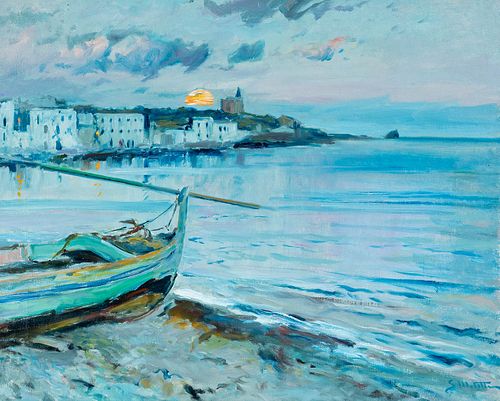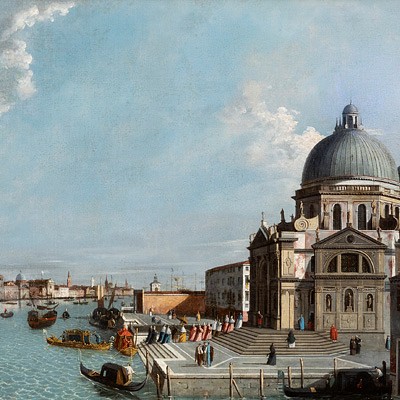SEGUNDO MATILLA MARINA (Madrid, 1862 - Teià, Barcelona, 1937). "Cadaqués". Oil on canvas. Signed in the lower right corner.
Lot 1
About Seller
Setdart Auction House
Carrer Aragó 346
Barcelona
Spain
Setdart Subastas was born in 2004 and is currently the first online art auction in Spain with solidity, prestige and reliability guaranteed by our more than 60,000 users. Setdart has a young, dynamic and enterprising team ready to successfully manage the purchase and sale of art works through custom...Read more
Categories
Estimate:
EUR€6,000 - EUR€8,000
$6,250 - $8,333.33
Absentee vs Live bid
Two ways to bid:
- Leave a max absentee bid and the platform will bid on your behalf up to your maximum bid during the live auction.
- Bid live during the auction and your bids will be submitted real-time to the auctioneer.
Bid Increments
| Price | Bid Increment |
|---|---|
| EUR€0 | EUR€10 |
| EUR€200 | EUR€25 |
| EUR€500 | EUR€50 |
| EUR€1,000 | EUR€100 |
| EUR€3,000 | EUR€200 |
| EUR€5,000 | EUR€500 |
| EUR€10,000 | EUR€1,000 |
| EUR€20,000 | EUR€2,000 |
| EUR€50,000 | EUR€5,000 |
About Auction
By Setdart Auction House
May 18, 2021
Set Reminder
2021-05-18 09:30:00
2021-05-18 09:30:00
America/New_York
Bidsquare
Bidsquare : Classics XIX and XX
https://www.bidsquare.com/auctions/setdart-auction-house/classics-xix-and-xx-6961
The next 18th May there will be a 19th and 20th Century Classics Auction at Setdart.com There will be a select repertoire of important artists such as Carlos Cruz Diez, Luis Feito, Joan Miró, Fernando Botero, Josep Llimona, Salvador Dalí among others. Setdart Auction House sofia@setdart.com
The next 18th May there will be a 19th and 20th Century Classics Auction at Setdart.com There will be a select repertoire of important artists such as Carlos Cruz Diez, Luis Feito, Joan Miró, Fernando Botero, Josep Llimona, Salvador Dalí among others. Setdart Auction House sofia@setdart.com
- Lot Description
SEGUNDO MATILLA MARINA (Madrid, 1862 - Teià, Barcelona, 1937). "Cadaqués". Oil on canvas. Signed in the lower right corner. Measurements: 50 x 63 cm; 75 x 88 cm (frame). Segundo Matilla achieves in this canvas to print an eternal cadence to a fleeting moment, the one in which night and day exchange their chromatic palettes, and the glaucous lights stain everything with a magical patina. Thus, the beautiful coastal orography of Cadaqués is filled with an intense lyricism, gliding between infinite mottled blues, greens and pinks. Despite being born in Madrid, Matilla trained and developed his career in Barcelona. He studied at the School of Fine Arts in Barcelona, under the direction of Antonio Caba. An outstanding representative of Spanish impressionism, he participated in numerous exhibitions and official competitions held in Barcelona, such as the group exhibitions organized by the Círculo Artístico (1895), the International Exhibitions of 1891, 1894, 1896 and 1898 (honorable mention in 1891) or the Art Exhibitions of 1918 and 1919. In 1897 he obtained an honorable mention at the National Exhibition of Fine Arts in Madrid for his painting "Washerwomen of Galicia". He also showed his work in Paris, taking part in exhibitions such as the French Artists' Salon of 1897. Among his individual exhibitions, those held at the Salón Vilches in Madrid and, in Barcelona, at the Sala Parés (from 1907) and the Pallarés Galleries (1942), the latter a posthumous tribute, stand out. Several of his works exhibited there were bought by the Museum of Modern Art in Madrid, and many others were exported to America. Of special success was his very large exhibition (one hundred and fifty works) held at the Sala Parés in 1914, received with unanimous praise by the critics of the time. The following year it was presented in Madrid at the Salón Vilches, where all the works exhibited were sold. He achieved great public and critical success thanks to his landscapes of the Ampurdán, Camprodón, Port de la Selva and Cadaqués. A painter endowed with astonishing skill, a marked personality full of sensitivity, a mastery of drawing and pictorial technique and an overflowing capacity for work, Segundo Matilla was an excellent painter who cultivated absolutely all genres, being a great landscape painter and sailor, painting portraits of great quality, especially of people from the world of show business, and his flower paintings and still lifes were also highly appreciated. His paintings of bullfighting themes, painted with great spontaneity and full of movement, demonstrate his great fondness for the art of Cúchares. Within the landscape genre, Matilla showed a predilection for the evening hours, in the manner of Eliseo Meifrèn. He always painted in a totally intelligible way and without any kind of reflexive complications, ignoring absolutely all the artistic trends of his time. Segundo Matilla was also the teacher of outstanding painters of the following generation, among them his nephew, Joaquim Terruella, and Antoni Rosell Altamira. His work is currently exhibited in various museums, such as the aforementioned Museum of Contemporary Art in Madrid, the Prado Museum (works on deposit at the Economic Court of the Central Administration and the Municipal Museum of Malaga), the Pablo Gargallo Museum in Zaragoza and the National Art Museum of Catalonia, as well as in important international private collections.
- Shipping Info
-
In-House Shipping
-
- Buyer's Premium



 EUR
EUR CAD
CAD AUD
AUD GBP
GBP MXN
MXN HKD
HKD CNY
CNY MYR
MYR SEK
SEK SGD
SGD CHF
CHF THB
THB
















